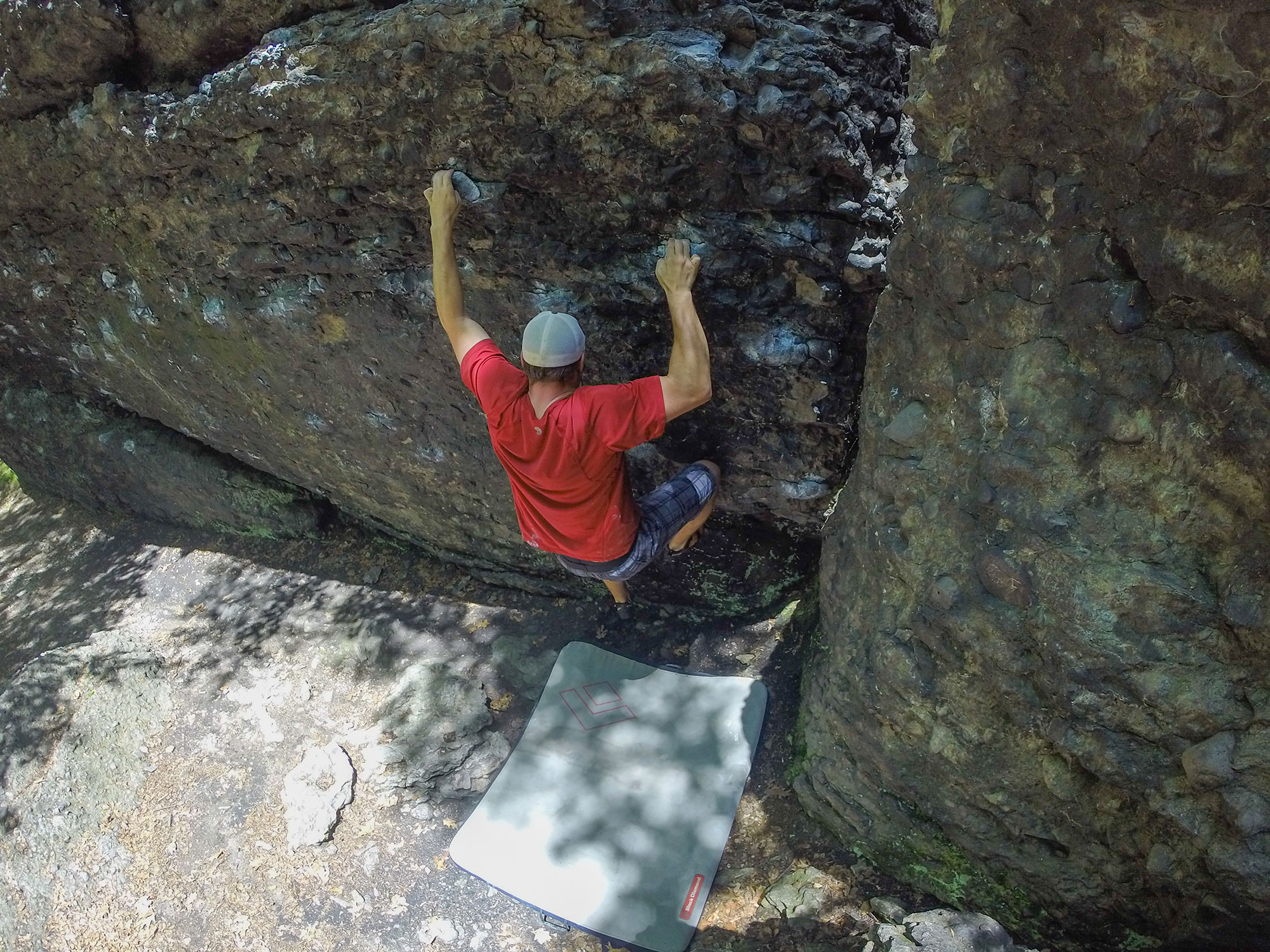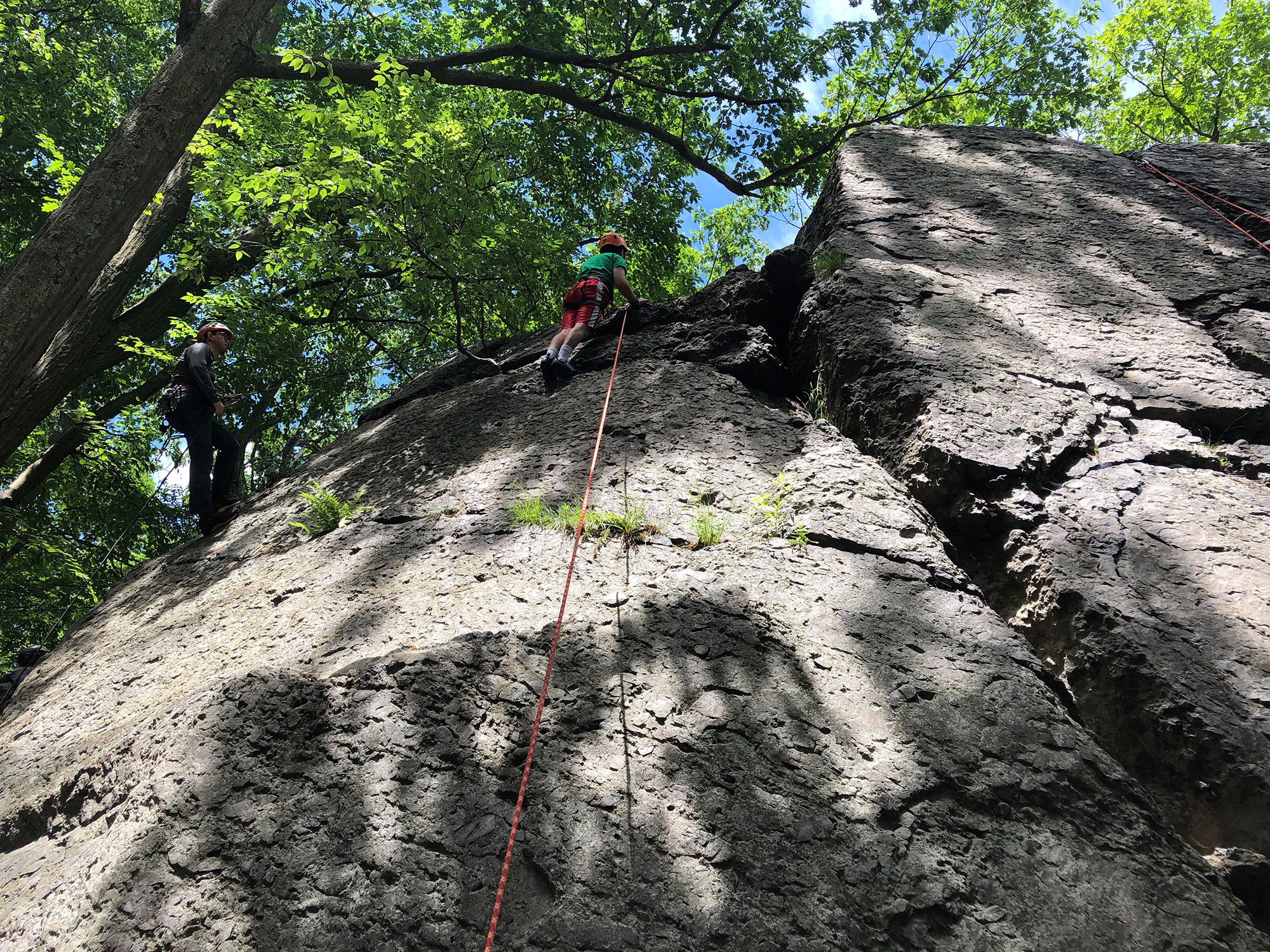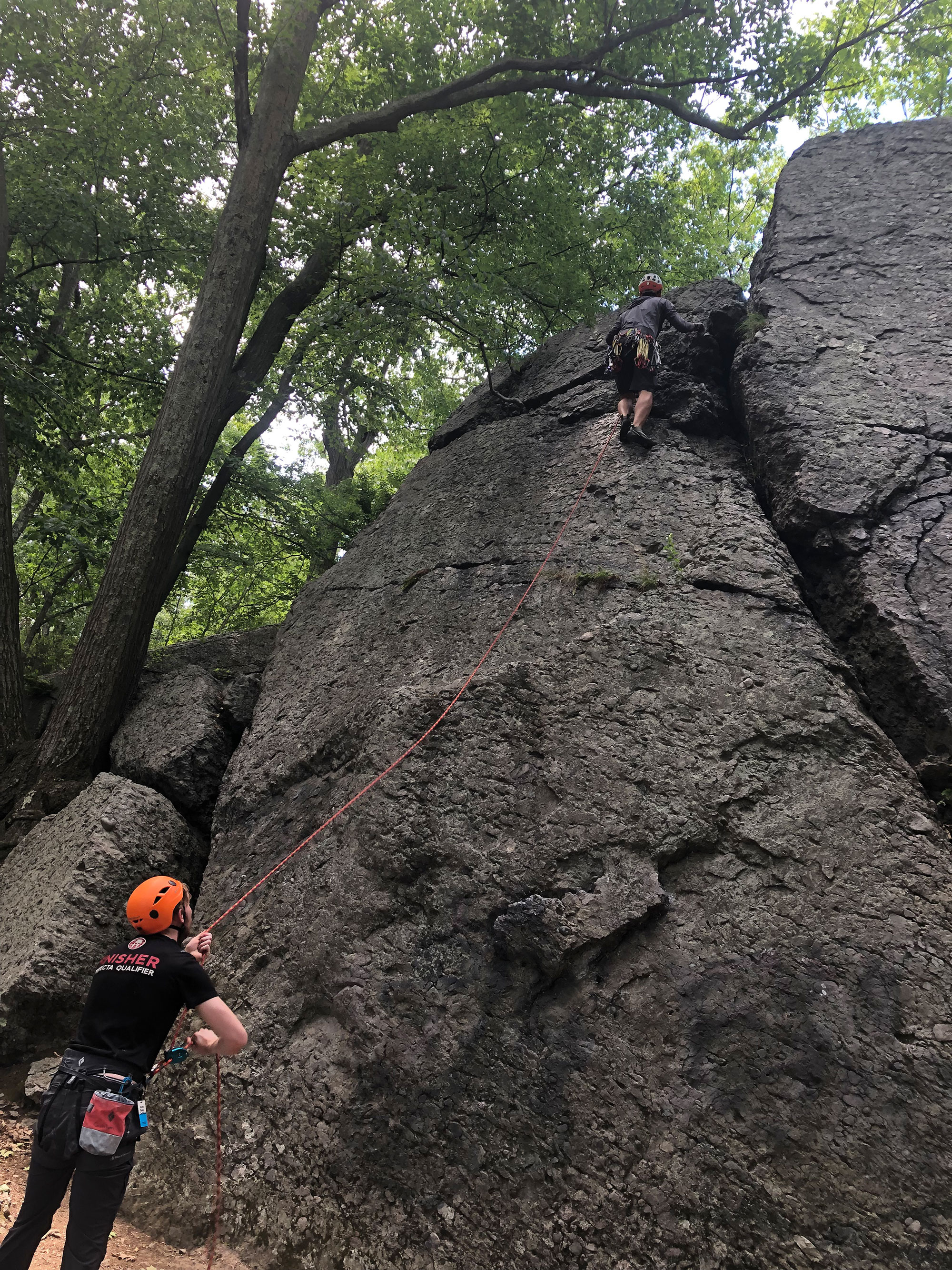Tucked behind the Chestnut Hill Mall and within earshot of the bustling traffic of Route 9, Hammond Pond is an unlikely spring climbing destination. But it delivers convenient climbing close to Boston and its suburbs along with diverse routes and styles—from easy trad climbs to hard boulder problems, sinker jams to tiny crimps. Even better, its comparatively mild weather makes it an ideal spot to get a jump on the season while more northern crags are still buried beneath snow and ice.

Unique Geology
Hammond Pond doesn’t offer the attention-grabbing geology of other must-visit spring locales, like the towering red walls of the desert, the gritty sandstone of the Southeast, or the strange formation of the West Coast, however, it does feature an extremely unique type of rock: Roxbury Puddingstone. The official state rock of Massachusetts, Roxbury Puddingstone, is a sedimentary conglomerate that consists of small- and medium-sized pebbles embedded in a concrete-like rock.
While sedimentary conglomerates can be found across the globe, Roxbury Puddingstone is unique to the Boston Basin—a depression bordered on three sides by higher ground and on one side by the ocean. The outer parameters of the Boston Basin are loosely defined by Route 128, with the bustling highway forming a border as it runs around the city.
In addition to being a unique type of rock, Roxbury Puddingstone provides distinctive features for climbing. These include pinching pebbles, pulling pockets (where pebbles are missing), and jamming cracks. Routes are found on everything from the tallish low-angle slab of Hammond Pond’s Main Wall to the short, steep bouldering walls of the Alcove.
Getting There
Getting to Hammond Pond is pretty straightforward. It’s located on Route 9, behind the Chestnut Hill Mall. Park in the lot on the left—near the pond—when entering the Chestnut Hill Shopping Center from Hammond Pond Parkway.
Hammond Pond is also accessed via the T. The D Line on the Greenline has a Chestnut Hill stop, and Hammond Pond is a 15-minute walk from there.

Bouldering at Hammond Pond
The Alcove is the most popular destination for boulderers and home to Hammond Pond’s best-known problems. The Alcove is best defined by its powerful fingery climbs, a wide variety of eliminates, and hazard-free landings. For those looking to build endurance, there are also a handful of established traverses, allowing climbers to milk a lot of climbing out of the relatively limited walls. Making the Alcove particularly well suited to spring climbing is that it’s south facing, receives a lot of sunshine, and its roughly 15-foot walls tend to trap warmth.
Must-try problems include:
- Warm-Up Traverse (V0): A low climb that traverses the obvious shelf—from right to left—in the middle of the left of the two prominent and well-chalked walls that make up the bulk of the Alcove. Drop to the ground or follow jugs to the top.
- Thank God Traverse (V0): Start on jugs next to a shelf on the right side of the right of the two most prominent boulders and work your way left. Follow the shelf to its terminus and top out.
- Crispy (V1): Located just left of the crack/gully separating the Alcove’s two most prominent boulders. Start on crimps and make a few fingery moves to a shelf beneath the top of the boulder. One big move from the shelf takes you to the top.
- Over Easy (V2): Sit start just beneath the shelf that makes up the Warm-Up Traverse and move up edges through the steepest part of the wall.
- Hammond Eggs (V3): Start from the right end of the shelf that makes up the Warm-Up Traverse and move up sharp, crimpy holds to a committing-feeling top out.
While most boulderers head to the Alcove, the Beached Whale Boulder—an obvious small block sitting just outside the Alcove—offers a few problems, including Beached Whale (V6), a short powerful problem that’s worthy of your tick list.
Just down the road is the Temple Area, named for its one-time adjacency to Congregation Mishkan Tefila (Boston College now owns the building). Pusherman Wall is the most well-traveled of the Temple Area blocks and home to the challenging must-send route Hepatitis (V5). It’s also where you’ll find the Hermit Cave and Hammond Pond’s steepest climbing.

Traditional and Top Rope Climbing
Roped climbing is also exceedingly popular at Hammond. Experienced and new trad climbers alike frequent the roughly 30-foot-tall Lower Wall—also referred to as Main Wall—to enjoy its gear-eating cracks, gentle angle, and moderate grades. Main Wall also offers easy-to-rig top ropes, which makes it appealing to everyone from groups of new climbers to those trying to get in some low-commitment early-season mileage. Just remember to bring long anchor lines, as the anchor trees are a ways back from the edge of the cliff.
Must-climb routes include:
- Free and Easy (5.4): Ascends the wide crack in the middle of the face while providing ample opportunity for gear and plenty of rest.
- The Cleft (5.4): Climb the crack on the far side of Main Wall. Great jams, good feet, and an abundance of gear make this a favorite of beginner climbers.
- Cracker Jack (5.6): A few face moves bring you to a shelf and a splitter finger crack. The crux is getting off the ground and to the shelf, with plenty of gear found above.
- Flutterby (5.6): Cobbles and jams take you to the top of this tricky crack. The gear is a little thinner here than on other Main Wall climbs.
Main Wall is popular, especially with groups, which can often make it challenging to find space. Luckily, there are some other, albeit less-traveled, walls. Lower Wall Right—located to the right of Main Wall, as its name implies—is a shorter, dirtier alternative to its popular neighbor. Up the hill, just past the Alcove, you’ll find the Vittles Wall with some steeper roped climbing and more challenging grades—the routes are predominantly in the 5.7-5.9 range and are better top-roped than led.
While the Main Wall and Vittles Wall are the most popular roped climbing areas at Hammond Pond, there are a bunch of other, smaller, climbing spots, too. Those interested in exploration will find plenty of routes off the beaten path.

A Crag for Every Season
Spring is a great time to visit Hammond Pond, but it’s truly a four-season crag that provides an escape from the gym in the winter, a great place to hone technique in the spring, a waterfront crag in the summer, and an escape from the hordes at destinations like Rumney, the Gunks, and Cathedral during Sendtember and Rocktober. While Hammond Pond can feel like a scrappy urban crag, keep in mind it’s where some of the legends of the sport cut their teeth—for example, the classic Hepatitis was established by Henry Barber.
Tim Peck and Doug Martland
Tim and Doug met long ago at the Eastern Mountain Sports in Canton, Massachusetts. Bonding over a love of slick Quincy Quarry granite, White Mountain sufferfests, and scheming up adventures while folding tee-shirts, today Tim and Doug collaborate to write about their favorite outdoor activities and occasionally get nostalgic about tee-shirt tables.
Related Posts
April 12, 2024
Explore Like a Local: The Outdoor Mecca of North Conway, NH
There's a lot to love about this New…
April 3, 2024
5 Things To Do in the Boston Area During Mud Season
Adventure opportunities are abundant…




